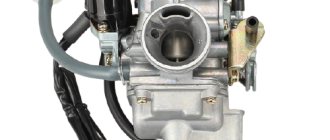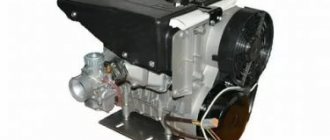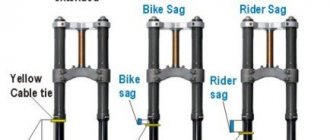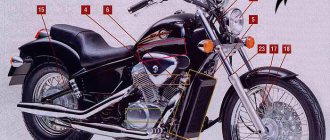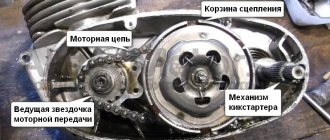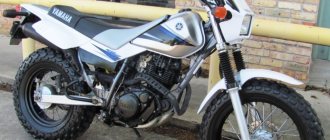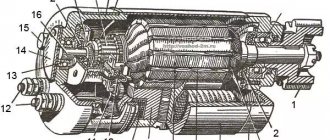Tuning the carburetor of a 4-stroke scooter is, of course, not rolling back the injector using broadband lambda
, but it also requires a competent approach and knowledge. For stable operation and efficiency, Chinese manufacturers have developed and implemented several design additions. Before you start adjusting the carburetor on a 4t scooter, it would be a good idea to become familiar with the structure of this device.
The main purpose of the main device of the power supply system is to prepare the optimal mixture entering directly into the cylinder. The carburetor consists of the following components:
- Frame.
- Throttle valve.
- Jets.
- Float system.
- Throttle valve.
- Acceleration pump.
- Start-up enrichment.
- Screws for adjustment.
- Dosing needle.
To create an enriched mixture when starting a cold engine, Chinese scooters are equipped with a starting enricher.
In the absence of voltage at its contacts, the needle completely releases the starting channel, which opens the way for an increased dose of fuel into the carburetor diffuser.
For efficiency indicators, the idle shutdown system is responsible, which disables the idle option under load.
Despite the complexity of the design, servicing the carburetor unit is quite within the capabilities of a novice mechanic. Before starting the process, it is worth installing a proven spark plug, as well as a good air filter element. Adjusting the carburetor on a 4t scooter should be done with the engine warm. The process consists of the following operations:
- idle speed adjustment;
- adjusting the quality of the mixture with a screw;
- adjusting the mixture quality with a needle;
- adjusting the fuel level in the float chamber.
The carburetor design includes a screw that controls the engine speed at idle.
When it is tightened, the air supply channel becomes smaller, as a result of which the fuel mixture is enriched and the number of revolutions increases. To reduce this indicator, accordingly, the screw must be unscrewed. The process is controlled by gradually unscrewing every quarter turn.
Compliance with the proportions of the combustible mixture is the main condition for the smooth and stable operation of the scooter.
This condition is met, depending on the model, by adjusting the throttle valve with the appropriate screw or needle. The mixture becomes richer when the screw is turned clockwise or when the needle is raised.
Exactly the opposite is the process of composition depletion. On a new product, it is considered normal for the screw to be unscrewed by 1.5-2 turns. The degree of engine wear and the presence of other breakdowns can expand this range. Experienced mechanics check the accuracy of the settings by checking the spark plug.
The amount of fuel in the float chamber is checked when the scooter engine is running by lifting the fuel supply tube up. Non-compliance of the level with technical standards is eliminated by adjusting the needle holder within small limits. Adjusting the carburetor on a 4t scooter can be considered complete if there are no unwanted dips or detonation during a test ride.
Thursday, September 28, 2021
Carburetor diagram for 139qmb
Check all O-rings for damage. Replace if necessary.
When cleaning the carburetor, remove the vacuum diaphragm before using purge air or cleaning solvents. This will prevent damage to the diaphragm.
Possible malfunctions of the CVK carburetor
1.The engine is difficult to start
— No spark - Poor compression
2. There is no fuel in the carburetor
-Closed fuel line -Closed fuel filter -Blocked vacuum line -Damaged Broken vacuum line -Clogged inlet needle -Float level set too high
3. Too much fuel for the engine
-Dirty air filter -Air leak in the manifold -Faulty enrichment valve -Blocked air passage in the carburetor
4. Air/fuel mixture too rich or too pale
-Faulty enrichment valve -Tightened idle screw -Float needle stuck or dirty -Float height too high or too low -Blocked carburetor air passage -Dirty air filter -Carburetor or manifold air leak
5. Engine does not accelerate
-Bad spark -Air mixture screw too tight -Accelerator pump faulty
6. Almost does not respond to the throttle
-Weak spark/poor ignition -Blocked fuel line -Blocked fuel filter -Bad fuel -Water in fuel -Air leak in carburetor or manifold -Faulty enrichment valve -Fuel flow difficult in carburetor -Vacuum choke stuck -Damaged vacuum diaphragm -Dirt in carburetor
Removing the carburetor
1. Remove the seat and container underneath. 2. Remove the right side panel. 3. Disconnect the starter cable connector. 4. Loosen the carburetor drain screw and drain the fuel from the float chamber. 5. Loosen the clamps in the intake pipe and intake manifold. 6. Loosen the throttle cable and pull it out of the caliper and out of the throttle control sector. 7. Disconnect the fuel line from the carburetor. 8. Remove the air intake tube and pull the carburetor straight back out of the intake manifold. 9. Remove the starter enricher from the carburetor.
Checking the enrichment valve
1. Check the resistance level. 2. The standard value is below 5 if it is cold. 3. Connect the enricher to a 12 V battery. 4. The plunger should extend 3/8 inch (approximately 10 mm) after 5 minutes.
5. Check the needle and its working place in the carburetor. 6. Replace if necessary. 7. Place the enrichment valve in the installation location and press down. 8. Install the retaining ring and tighten the screws.
Air shut-off valve
1. Unscrew the two screws of the traverse, the throttle cable, and remove it. 2. Unscrew the two screws of the air shut-off valve. 3. Remove the spring and vacuum membrane. 4. Check for membrane wear, replace if necessary. 5. Clean the channels, remove dirt.
Vacuum chamber
1. Remove two screws and remove the cover. 2. Remove the spring and membrane flap. 3. Remove the fuel needle. Be especially careful not to damage the membrane. Replace if damaged.
This is interesting: How to get to a gas station with an empty tank
1. Check the needle for wear and replace if necessary.
Float chamber.
1. Remove the three screws and float chamber pan. 2. Remove the pin that holds the float. 3. Remove the main fuel jet, idle speed jet and idle mixture quality adjustment screw.
Be careful not to break the fuel jets and mixture screw. Count the number of revolutions when removing the mixture quality screw. When reinstalling the jets and screw, do not tighten them.
4. Clean the jets with solvent and compressed air. 5. Clean the carburetor body and all passages with compressed air.
1. Check the float needle and its seat and blow off any dirt. 2. Install the idle jet, fuel needle nozzle, main fuel jet into the carburetor.
3. Install the float. Adjust the fuel quality screw. Standard setting is 2 turns, plus or minus 1/4 turn. 4. After installing the float chamber pan, check the fuel level using a small ruler or calibrator. The correct fuel level is 20.5 mm (0.807 in).
Design and connection of a Yamaha scooter carburetor
The Yamaha Jog scooter is one of the most popular on the Russian market: this is explained by the simplicity and reliability of the model, and its affordable price. The carburetor design of this scooter is standard, so you can figure it out using the description given above. However, when installing it, inexperienced owners may encounter some difficulties, which we will help you sort out.
Carburetor of a Japanese scooter Yamaha Jog
The device is worth considering in more detail. This will help you understand not only how to adjust the carburetor and use it correctly, but also how to connect it correctly.
- A starter enricher is attached to the carburetor body: it is small in size and housed in a plastic case. It has two bolts with rubber seals. The enricher is powered via a 12 V battery. This device is used to start the engine when cold, as it allows you to automatically enrich the mixture with oxygen.
- The fitting is connected to the fuel supply hose coming from the gas tank tap.
- If the enrichment unit needs to be removed, you will need to not only unscrew the bolts, but also disconnect the electric valve, to which there are only two wires.
- The mixing chamber has a special cover to which a bolt is attached. If you unscrew it, you can get to the throttle valve. This allows you to check whether the throttle cable is connected, and also to get to the needle that regulates the level of fuel and air supply. If the carburetor needs cleaning, you will definitely need to remove the throttle.
- The enrichment connector has two wire outputs, the yellow one is connected to the generator, the green one goes to ground. In principle, if you reverse the polarity, nothing will happen and the device will still work.
- For the enricher to operate, voltage must come from the battery. When the element inside the device heats up, the needle will extend.
- A special fitting is connected to the air filter, and there is a rubber elbow between them.
- There are several screws on the carburetor body with which you can adjust the idle speed and mixture quality.
- The float chamber is screwed from below and has 4 mounting bolts.
- There is an additional fitting for oil supply: it is the smallest.
- The second fitting is needed for communication with the atmosphere; you do not need to put anything on it.
- The third one is connected to a gas hose. It goes to the gas tank vacuum valve.
4t scooter carburetor design
Let's start studying the operation of the carburetor with the accelerator pump
The accelerator pump is activated only when the throttle is sharply opened, when sharp acceleration needs to be achieved from the scooter, the carburetor systems have some inertia and cannot respond to the throttle in a timely manner, so to avoid failure when the throttle is sharply opened, the designers have implemented The carburetor is an additional module that injects a portion of fuel at the right moment, which allows you to smooth out the characteristics of the engine during dynamic acceleration.
Disassembled accelerator pump
Acceleration pump drive
Accelerator pump channels
General structure of the carburetor
Carburetor without top cover
Never try to stretch the spring; its force is strictly calibrated.
Idle fuel quantity (quality) screw
The “quality” screw is assembled, when reinstalling the screw, follow the correct order of installing the O-rings, first install the spring, then the aluminum washer and the rubber O-ring.
To ensure greater engine efficiency, an idle cut-off system was introduced into the carburetor; this system turns off idle when it is no longer needed, which ultimately has a positive effect on the overall efficiency of the engine.
In the carburetor, to control the operation of the idle air shut-off system, there is a special channel through which the vacuum is transmitted to a membrane which, using a rod, opens or closes the valve, thereby turning off or turning off the idle air system.
Carburetor adjustment with screws
First of all, before proceeding with the appropriate adjustment, it is necessary to debug the ignition system, make sure that the spark plugs are in good condition, adjust the fuel supply system, set the permissible gap on the device for automatically interrupting the current circuit, remove the gas pedal rod from the throttle valve and only then proceed to carburetor settings.
The engine must be warmed up to operating condition, otherwise after debugging “cold” during operation it will work completely differently. We completely disconnect the crankcase tube, completely eliminating the influence on the crankcase gas setting. The equipment you will need is a simple slotted screwdriver and preferably a tachometer (digital, since the dial does not show revolutions up to 10 units). In service centers, they could use a gas analyzer as a necessary, but not obligatory, one for fine tuning, but we will make do with the specified accessories.
- We reduce the number of idle speeds to a minimum using the “quantity” screw (the engine is running, but is about to stall).
- Using the “quality” screw, we look for the position at which the number of revolutions is maximum. We begin to screw it in, raising the speed; if the engine stalls, we unscrew it to the required criterion.
- We check the quality of the fuel mixture.
Give the gas sharply - the engine should not stall. If it suddenly stalls, then unscrew the “quality” screw until the engine starts working normally. The setup is complete.
Experienced drivers make such adjustments “by ear” based on the sound of the engine; for “confident” drivers, there are many instructions and training videos; for “beginners”, it is better to carry out the correct carburetor adjustment in the appropriate service centers.
Adjusting the carburetor of a 4t scooter
One of the most important parts of any scooter is the carburetor; it is responsible for the correct supply of fuel, and therefore you should have a properly configured carburetor. Initially, the manufacturer makes scooters that would be suitable for a certain climatic situation, and the fuel system may not be able to cope with our weather changes, as a result of which the carburetor does not work correctly and most often does not maintain speed. That is why modern scooters are equipped with various adjusting bolts so that the vehicle owner can adjust the engine to the desired parameters, and adjusting the scooter’s carburetor does not cause difficulties.
A carburetor is a specific part of a scooter that is responsible for preparing the fuel mixture, mixing gasoline with air. The standard ratio of gasoline to air is 1 to 15, so any carburetor should produce these figures. Also, depending on this ratio, the mixture may be different; in the above parameters it will be optimal. But if you want to get a mixture that does not stall the engine at idle, use a ratio of 1 to 13.
After this, you can call the mixture “rich.” And finally, the last type is a lean mixture. This is the worst option, where the ratio of fuel to air is 1 to 17. With a lean mixture, there is a risk of carbon formation in the piston and its complete breakdown, so next we will talk about how the carburetor is adjusted on a 4t scooter.
Design, configuration and malfunctions of a four-stroke scooter carburetor
The article describes in detail the design and principle of operation of the carburetor. Possible malfunctions and methods for eliminating them are given, as well as recommendations for setting up the carburetor.
Before writing this article, I read publications about carburetors on the RuNet. I only discovered that Moto magazine published similar information in the October 2005 issue. I never found the article itself.
The principle of operation of a carburetor. Much has been written about the principle of operation of a carburetor; in my opinion, this is described most fully and accessiblely in an article found on the Internet:
Principle of operation and adjustment of the carburetor Many sooner or later face, for some reason, the need to adjust the carburetor. But not everyone knows how to do it correctly. This article may be useful to you in such a situation. At first glance, a carburetor looks like a complex device, but with a little theory, it will be easier for you to adjust it. The first thing you need to know is at least the basics of the principle of operation of the carburetor and its main controls and adjustments. Let's start with the basics. Let's look at the principle of operation of a carburetor using the example of Figure 1:
For the correct dosage of fuel and air, jets are installed in the places where they are taken. What is this, a jet? Schematically in cross-section it looks as shown in Figure 5:
What is a float chamber? This is the container in the carburetor where the fuel is located. With the help of a plastic or iron float, the level of gasoline in the chamber always remains stable. As soon as the fuel begins to decrease, the float lowers and the needle to which it is connected opens the fuel supply hole from the gas tank. Gasoline begins to flow, the float rises again and the level stabilizes.
It is worth mentioning that when the engine is cold, it does not have enough fuel to start properly and the mixture needs to be richer. Agree, turning the screws and changing jets for this is not very convenient :o) For this purpose, an additional channel for supplying the fuel mixture was created, very similar to the main one, only smaller in size. There is also an air damper and a needle, but the damper is controlled mainly in two ways: 1). Manual control. There is a lever installed on the steering wheel. When cold, you turn it, an additional channel opens and additional mixture flows in. As it warms up, turn the lever to its original position. 2). Automatic control. The needle and flap are connected to a device that is forced to heat up. Heating often occurs with a coil (similar to a boiler) connected to a generator. In this case, the material that heats the spiral expands and pushes the rod to which the air damper with a needle is attached. The warm-up time is optimally calculated, and after a certain time (approximately 3 to 7 minutes) the channel is completely closed.
It should be noted that carburetor adjustment should be carried out only on a well-warm-up engine. On a cold engine, the auxiliary fuel supply valve will not close and the engine will not operate properly due to its not fully warming up. Start adjusting immediately after you have ridden the scooter or after 10-15 minutes of warming up. Also, before adjusting, check, or better yet, replace with a new spark plug. Check the air filter for contamination, clean it or replace it with a new one. Make sure the exhaust system is clean. It is also advisable to rinse in gasoline and blow out all channels and jets in the carburetor with compressed air. Only after this you can start making adjustments.
The design of a four-stroke scooter carburetor.
Well, now I will describe the features of the device and possible malfunctions (as well as methods for eliminating them) of the carburetor installed on 4-stroke scooters. Overall this carburetor is of good quality. Only the inlet pipe had irregularities and cavities on the inner surface, which had to be sanded with sandpaper and then polished with polishing paste.
Dismantling. Remove the seat with the helmet box (4 nuts and 2 screws under the mat, read more in the article “Adjusting the valve clearance”). Here it is, the carburetor.
Adjusting the carburetor of a 4-stroke scooter
In general, the number of strokes in a scooter does not play such an important role when adjusting, because the jets are almost the same everywhere (fuel and idle), so the process occurs according to the individual indicators of the scooter.
Important
: Adjustment of the carburetor of a 4t 80cc scooter or other volume is carried out only on a warm engine. It is also important to consider that before adjusting, the carburetor must be disassembled and cleaned of dirt.
Setting up the carburetor includes several manipulations:
- Fuel level adjustment;
- Idle speed adjustment;
- Adjusting the quality of the mixture using a jet;
- Adjusting the quality of the mixture by setting the needle position.
Let's start with the simplest action - adjusting the idle speed.
The principle of operation of a scooter carburetor
The carburetor design of a 4t scooter is not very complicated. The basic principle of its operation is as follows: a certain amount of fuel and oxygen enters the float chamber of the device, where they are mixed in the required proportions and supplied to the combustion chamber of the engine.
The design of a 4-stroke scooter carburetor may vary slightly depending on the model, but in general it is the same for all types of carburetors. The float version of products is most often used. It is distinguished by the presence of a float chamber in which fuel is mixed with air, after which the finished mixture is fed into the cylinder. In order for air to enter the fuel in the required proportion, the carburetor includes the following elements:
- Jets.
- A needle that meters the supply of oxygen.
- Spool.
- Throttle valve.
Sometimes the design of a 4t carburetor on a 50cc scooter includes an element such as an accelerator pump. It works in tandem with a starting mixture enricher. These devices help the scooter engine to work correctly and start in damp and wet weather. The correct operation of the motor depends on the coherence of the devices, so it is important to pay attention to their settings.
1 – starting enrichment, 3 – float, 4 – float chamber, 5 – main jet, 6 – carburetor heater, 7 – throttle with needle
Scooter starter booster
Most often, scooters are equipped with an electric starting enrichment; on older models you can find a manual one. The task of this device is to create the right mixture in order to start the engine after a long period of inactivity.
Starting enrichment device
The carburetor has an additional channel for connecting the enricher. If the device is automatic, the channel opens itself when you try to start the scooter and closes as the engine warms up. If the enrichment is manual, you need to close its valve yourself. The operating principle of the device is as follows:
- Inside the housing there is an element heated by electricity, which pushes out a needle that blocks the fuel channel.
- After the engine is stopped, the needle will be retracted.
Float chamber device
Mixing of fuel with air in the carburetor occurs with the participation of the float chamber; Thus, the finished fuel, saturated with the required amount of oxygen, enters the combustion chamber, where it explodes and sets the scooter in motion.
Float chamber device
From the gas tank, fuel enters the carburetor through special pipes. But mixing cannot occur in them, so first the fuel ends up in the float chamber, and only then it is enriched with oxygen and further moved. To ensure that gasoline does not flow continuously, but in the right quantity, the carburetor is equipped with a special system with a float and valve. When the chamber is full, the float rises and the valve blocks fuel from entering the carburetor; when the float is lowered, the flow of fuel resumes.
Adjusting the idle speed on a scooter
After the engine is warmed up, you can adjust the idle speed, this is done using a special screw located on any carburetor. The idle speed is adjusted to ensure that the scooter operates correctly and smoothly when not in use. The location of the screw may vary depending on the scooter model. For example, on a Honda scooter the screw is located in the center, and the mixture quality screw is installed on the left side.
The adjustment process is quite simple, as soon as the scooter starts, rotate the screw, where when tightened the speed will increase, opening the jet reduces the speed. Again, adjustments are made only on a well-warmed engine.
Setting up the carburetor on a scooter
Adjusting the scooter carburetor In order for the scooter to work properly, the carburetor must be properly adjusted. An incorrectly configured carburetor leads to increased fuel consumption, loss of idle speed, loss of power and incorrect engine operation.
When is carburetor adjustment necessary? The need to adjust the carburetor arises after a major overhaul of the engine, replacement of the carburetor, its repair and cleaning. On different scooter models, some adjustment nuances may vary, but the principle is always the same. Let's look at setting up the carburetor on such a popular scooter as the Honda Dio. Adjustment steps When adjusting the carburetor, idle speed and mixture quality are adjusted by moving the needle and a special screw, as well as adjusting the fuel in the float chamber.
Adjusting idle speed and mixture quality Before you begin adjustment, you need to warm up the engine thoroughly. On the Honda Dio scooter, the idle speed adjustment screw is located in the center, and the mixture quality adjustment screw is located to the left. According to the factory parameters for the Honda Dio scooter and other models of Honda scooters, the engine should operate with the mixture quality screw unscrewed by 1.5-2 turns. In this case, it is necessary to adjust the idle speed so that the engine runs stably and does not stall. A decrease in idle speed occurs when the screw is unscrewed, and an increase on the contrary. On some models of Suzuki scooters, the mixture quality is regulated only by moving the needle in the throttle valve. How to adjust the fuel level
Setting the fuel level
This procedure is also carried out using a jet located at the very bottom of the float chamber. The first step is to unscrew this screw, but gasoline should not come out of the tube. The tube is located below the jet and is usually transparent. It shows the fuel level, so lift it in a vertical position. If the fuel level in the float chamber is normal, the gasoline in the tube will be slightly less than the cap curb.
Important
: You need to check this indicator only with a warm running engine.
Adjusting the fuel level in the carburetor of a 4t scooter is as follows: remove the float chamber and find the needle inside. The needle has marks and a small locking ring. You can increase the fuel level by installing the ring above this indicator, and decrease it by doing the opposite.
This is interesting: Can you be fined if road markings are not visible?
Adjusting the fuel level in the float chamber.
You can check the fuel level in the float chamber using a transparent tube located at the very bottom of the carburetor. Unscrew the butter screw,
lift the tube up opposite the carburetor and check the fuel level. Please note that the fuel level must be checked with the scooter engine running, and the tube should always be located above the carburetor. The fuel level should be just below the cap curb.
If there is little, or usually a lot, remove the cover and adjust the moment of operation of the locking needle by bending the needle holder in very small ranges.
It should be noted if the carburetor has not been washed for a long time and there are signs of contamination of its channels and jets, if gasoline has been or is being filled with an octane rating lower than that recommended by the manufacturer (for example, A-80), if the installed jets and other parts do not correspond to those recommended by the factory parameters, then before adjusting the carburetor you need to eliminate all this, since further adjustment will only be temporary and you will not achieve the desired result.
Adjusting the mixture quality on a scooter
We indicated above that the mixture can be optimal, rich or lean. So, manufacturers of a certain scooter model recommend using specified proportions, which means that sooner or later you will have to make adjustments. Most 4t scooters have an adjustment screw, otherwise the procedure is done using a needle in the throttle. The mixture is enriched by turning the screw clockwise; when the screw is turned counterclockwise, the mixture becomes lean. Adjusting the indicator on scooters without a mixture quality screw occurs by increasing or decreasing the height of the needle.
Removing the carburetor
At the first stage, unscrew the 4 bolts and remove the seat compartment; on some models, the oil tank cover is also unscrewed. Then the air filter is removed, for which we release the screw of the clamp securing the cuff and 2 10-point bolts that secure the housing. The rubber cuff of the filter housing can be pulled off the carburetor with a certain amount of force. Now you need to disconnect the gasoline and oil hoses. For this purpose, the loops of the clamps are compressed and the two hoses are pulled together. Using a 10mm wrench, unscrew the nearest bolt attaching to the intake pipe. Unscrew the second bolt inside. At the moment, 2 hoses have already been released, 2 fastening bolts have been unscrewed. Now you need to remove the device, unscrew the throttle cover and remove the throttle. To finally release the device, you need to remove the protective cover of the starting enrichment from the latches and unscrew the 2 screws from the clamping bracket of the enrichment.
Disassembling the carburetor
Before unscrewing the carburetor, remove external dirt from it - oil, dust, sand. This is conveniently done with gasoline poured into a bath. We put on gloves, take a brush and clean the outer part. Now you need to shake the carburetor, rotating it in different directions to remove any remaining liquid. You can unscrew the transparent drain hose and drain the gasoline. It is convenient to work on a wide table, since small parts can be lost during disassembly.
Carburetor disassembly sequence: 1. First, you need to unscrew the 2 screws of the float chamber and remove the cover. 2. We study the structure of the carburetor in the form of a white float, 2 jets (main and idle), and a shut-off needle on the petal. 3. The float axis is removed and the float with the needle is released. Particular attention to small details. 4. Take a slotted screwdriver and unscrew 2 jets. There is no need to unwind anything else.
Carburetor cleaning
It is convenient to work with a special cleaner - ABRO, VELV, KERRY - the more expensive, the more effective: the thin tube fits well into the nozzle, the sprayer cap does not jam. The can is under high pressure and plays the role of a kind of compressor with the injection of a special flushing liquid. Do not forget about safety precautions: if the cleaner gets on your skin, it causes irritation, and you can get serious burns to your eyes. Safety glasses are required! Cleaning should be done in fresh air.
We insert the cleaner tube into the jets and blow through. We check the condition of all holes in the jets. If there are solid particles that the cleaner cannot remove, you need to clean the holes with a needle. When washing, a stream of solution sprays out of the nozzle. All carburetor channels are washed in the same way. Dirt actively accumulates in the float chamber cover - it is actually a fuel sump, so it must be wiped thoroughly.
Carburetor installation
Assembling and installing the device after washing is in the reverse order. Particular attention should be paid to the installation of the throttle. The damper must fit completely into the carburetor; to do this, turn it until it sits “head down”. Screw on the lid. If you don’t have a cleaner at hand, you can wash all the parts in gasoline and blow them out using a pump or compressor, having previously placed a special nozzle with a pointed tip on it.
You can see the cleaning process with your own hands in the video.

